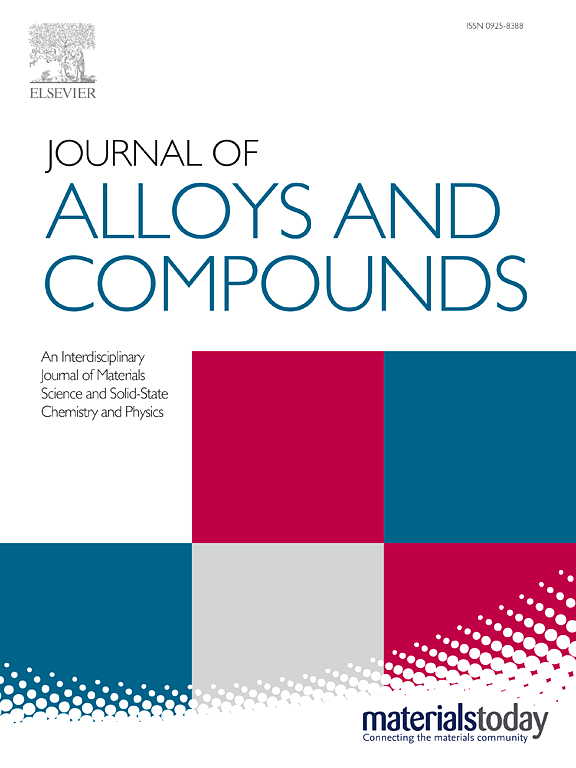Effect of Solid-Solution Treatment and Cooling Method on Texture Evolution and Properties of Super Invar Alloy Fabricated by Laser Powder Bed Fusion
IF 5.8
2区 材料科学
Q2 CHEMISTRY, PHYSICAL
引用次数: 0
Abstract
Tailored heat treatment is crucial for achieving the desired low coefficient of thermal expansion (CTE) and high elastic modulus (E) of laser powder bed fusion (LPBF) processed Super Invar alloy (Fe-32Ni-4Co) in semiconductor equipment and other precision devices. This paper thoroughly investigates the effect of solid-solution treatment (at 830 ℃ and 1030 ℃) and cooling method (Furnace cooling, air cooling, oil cooling and water quenching) on the microstructures, mechanical properties, magnetic properties and thermal expansion behaviors of LPBF manufactured Super Invar alloy samples. Faster cooling rate is favorable for the development of stronger textures of Copper components, while WQ and particularly FC can lead to Goss component enhancement. The as-built Super Invar alloy samples contain relatively high residual compressive stresses. Solid-solution treatment at higher temperature and faster cooling rates can more effectively relieve these compressive residual stresses and induce higher internal tensile stresses in the interior. Solid-solution treatment at 1030 ℃ results in lower strength, hardness and elastic modulus than at 830 ℃. The hardness, strength, elastic modulus and average CTE within 30~100 ℃ are generally negatively correlated with cooling rate despite the abnormal enhancement in water-quenched samples. Attributed to water-quenching-induced <111> and <110> texture generation, the water-quenched samples, particularly solution-treated at 1030 ℃, exhibit notable rigidity recovery. Strong magnetostriction effect, which may be attributed to the poor elastic property, is observed within the oil-cooled samples showing the lowest thermal expansions. A negative correlation between Curie temperature and cooling rate can be clearly identified. The vertically-measured saturation magnetization variation generally follows the intensity variation of dominant Goss textures of the columnar grains within side surfaces, while the horizontally-measured saturation magnetization value is positively correlated with the intensity of notable Copper textures within the equiaxed-grain zone. The furnace-cooled samples solution-treated at 830 ℃ exhibit the highest rigidity (Vertical E: 155.7 GPa. Horizontal E: 130.5 GPa) and strength but even higher CTEs (above 1.0×10-6 °C-1, 30~100 °C) than the standard suggests. The oil-cooled treated samples solution-treated at 830 ℃ possess the lowest CTEs (0.20×10-6~0.40×10-6 °C-1, 30~100 °C) at the sacrifice of relatively small E decline (Vertical E: 136.6 GPa. Horizontal E: 123.5 GPa). The water-quenched ones solution-treated at 1030 °C demonstrate comprehensively acceptable CTEs (0.40×10-6~0.80×10-6 °C-1, 30~100 °C) and superior stiffness performance (Vertical E: 152.4 GPa. Horizontal E: 119.3 GPa). Targeted selection towards detailed requirement of static and dynamic dimensional stability under specific circumstances among these recommended heat treatment practices would be advisable during engineering application of LPBF processed Super Invar alloy components.固溶处理和冷却方式对激光粉末床熔合超级Invar合金织构演变和性能的影响
在半导体设备和其他精密设备中实现激光粉末床熔合(LPBF)加工的超级英瓦合金(Fe-32Ni-4Co)所需的低热膨胀系数(CTE)和高弹性模量(E),定制热处理至关重要。本文深入研究了固溶处理(830℃和1030℃)和冷却方式(炉冷、风冷、油冷和水淬)对LPBF制备的Super Invar合金试样的组织、力学性能、磁性能和热膨胀行为的影响。更快的冷却速度有利于铜组分织构的增强,而WQ,特别是FC可以导致Goss组分的增强。超级英瓦尔合金试样具有较高的残余压应力。在更高温度和更快冷却速率下的固溶处理可以更有效地消除这些压残余应力,并在内部产生更高的内部拉应力。1030℃固溶处理的强度、硬度和弹性模量低于830℃固溶处理。在30~100℃范围内,硬度、强度、弹性模量和平均CTE均与冷却速率呈负相关,但在水淬试样中存在异常强化。归因于水淬引起的<;111>;和& lt; 110年比;织构的生成,水淬试样,特别是1030℃固溶处理的试样,表现出明显的刚性恢复。油冷样品的热膨胀最小,具有较强的磁致伸缩效应,这可能是由于弹性较差所致。居里温度与冷却速率呈负相关关系。垂直测量的饱和磁化强度变化一般遵循侧表面柱状晶粒优势Goss织构的强度变化,而水平测量的饱和磁化强度值与等轴晶区显著的Copper织构强度呈正相关。830℃固溶处理的炉冷样品具有最高的刚性(竖向E: 155.7 GPa)。水平E: 130.5 GPa)和强度,但CTEs(高于1.0×10-6°C- 1,30 ~100°C)比标准建议的还要高。830℃固溶处理的油冷样品CTEs最低(0.20×10-6~0.40×10-6°C- 1,30 ~100°C),但E下降幅度较小(垂向E: 136.6 GPa)。水平E: 123.5 GPa)。经1030℃固溶处理的水淬材料的cte值(0.40×10-6~0.80×10-6°C- 1,30 ~100°C)完全可以接受,且具有优异的刚度性能(垂向E: 152.4 GPa)。水平E: 119.3 GPa)。在LPBF加工的超级Invar合金部件的工程应用中,建议在这些推荐的热处理方法中,针对具体情况下的静态和动态尺寸稳定性的详细要求进行有针对性的选择。
本文章由计算机程序翻译,如有差异,请以英文原文为准。
求助全文
约1分钟内获得全文
求助全文
来源期刊

Journal of Alloys and Compounds
工程技术-材料科学:综合
CiteScore
11.10
自引率
14.50%
发文量
5146
审稿时长
67 days
期刊介绍:
The Journal of Alloys and Compounds is intended to serve as an international medium for the publication of work on solid materials comprising compounds as well as alloys. Its great strength lies in the diversity of discipline which it encompasses, drawing together results from materials science, solid-state chemistry and physics.
 求助内容:
求助内容: 应助结果提醒方式:
应助结果提醒方式:


